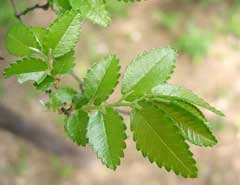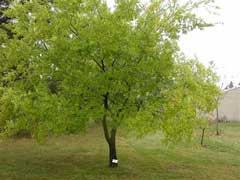 |
|
commons.wikimedia.org/wiki/User:KENPEI |
 |
| commons.wikimedia.org/wiki/User:Abrahami |
Translate this page:
Summary
Bloom Color: Green. Main Bloom Time: Early fall, Late fall, Mid fall. Form: Rounded, Vase.
Physical Characteristics

 Ulmus_parvifolia is a deciduous Tree growing to 18 m (59ft) by 18 m (59ft) at a medium rate.
Ulmus_parvifolia is a deciduous Tree growing to 18 m (59ft) by 18 m (59ft) at a medium rate.
See above for USDA hardiness. It is hardy to UK zone 5 and is not frost tender. It is in leaf from March to January, in flower from September to October, and the seeds ripen from October to November. The species is hermaphrodite (has both male and female organs) and is pollinated by Wind.
Suitable for: light (sandy), medium (loamy) and heavy (clay) soils and prefers well-drained soil. Suitable pH: mildly acid, neutral and basic (mildly alkaline) soils. It can grow in semi-shade (light woodland) or no shade. It prefers moist soil. The plant can tolerate maritime exposure.
UK Hardiness Map
US Hardiness Map
Synonyms
U. chinensis.
Plant Habitats
Edible Uses
Leaves - raw or cooked[105, 177]. Immature fruits, used just after they are formed - raw or cooked[105, 132]. An aromatic, unusual flavour, leaving the mouth feeling fresh and the breath smelling pleasant[132]. It contains about 34.4% protein, 28.2% fat, 17% carbohydrate, 5% ash[132]. Inner bark - cooked. A mucilaginous texture[105, 177]. No more details are given but inner bark is often dried, ground into a powder and then used as a thickening in soups etc or mixed with cereals when making bread[K].
References More on Edible Uses
Medicinal Uses
Plants For A Future can not take any responsibility for any adverse effects from the use of plants. Always seek advice from a professional before using a plant medicinally.
The leaves are antidote and lithontripic[218]. The stem bark is demulcent, diuretic, expectorant, febrifuge, hypnotic and lithontripic[178, 218]. The flowers are used in the treatment of fevers and neuritis[218].
References More on Medicinal Uses
The Bookshop: Edible Plant Books
Our Latest books on Perennial Plants For Food Forests and Permaculture Gardens in paperback or digital formats.

Edible Tropical Plants
Food Forest Plants for Hotter Conditions: 250+ Plants For Tropical Food Forests & Permaculture Gardens.
More

Edible Temperate Plants
Plants for Your Food Forest: 500 Plants for Temperate Food Forests & Permaculture Gardens.
More

More Books
PFAF have eight books available in paperback and digital formats. Browse the shop for more information.
Shop Now
Other Uses
Fairly resistant to maritime exposure, it can be grown in a shelter belt[K].
Special Uses
References More on Other Uses
Cultivation details
Landscape Uses:Aggressive surface roots possible, Pollard, Specimen, Street tree. Easily grown in any soil of at least moderate quality so long as it is well drained[1]. Fairly tolerant of maritime exposure, it succeeds outdoors in a very exposed position at Rosewarne in N. Cornwall[K]. Resistant to 'Dutch elm disease', a disease that has destroyed the greater part of all the elm trees growing in Britain. The disease is spread by a beetle. There is no effective cure (1992) for the problem, but most E. Asian, though not Himalayan, species are resistant (though not immune) to the disease so the potential exists to use these resistant species to develop new resistant hybrids with the native species[200]. The various species hybridize freely, the pollen stores well and can be kept for use with species that flower at different times[200]. Trees retain their leaves until early in the new year[11] and in areas with mild winters will often retain them until new leaves are formed in the spring[188]. A good companion for grapes[18]. There are some named forms, developed for their ornamental value. 'Frosty' and 'Geisha' are small bushes whilst 'Pumila' is a minute bush for the rock garden. Special Features:
Not North American native, Inconspicuous flowers or blooms.
References Carbon Farming Information and Carbon Sequestration Information
Temperature Converter
Type a value in the Celsius field to convert the value to Fahrenheit:
Fahrenheit:
The PFAF Bookshop
Plants For A Future have a number of books available in paperback and digital form. Book titles include Edible Plants, Edible Perennials, Edible Trees,Edible Shrubs, Woodland Gardening, and Temperate Food Forest Plants. Our new book is Food Forest Plants For Hotter Conditions (Tropical and Sub-Tropical).
Shop Now
Plant Propagation
Seed - if sown in a cold frame as soon as it is ripe, it usually germinates within a few days[200]. Stored seed does not germinate so well and should be sown in early spring[200]. One to two months stratification can improve germination rates. The seed can also be harvested 'green' (when it has fully developed but before it dries on the tree) and sown immediately in a cold frame. It should germinate very quickly and will produce a larger plant by the end of the growing season[80]. When they are large enough to handle, prick the seedlings out into individual pots and grow them on in the greenhouse for their first winter. Plant them out into their permanent positions in late spring or early summer, after the last expected frosts. Plants should not be allowed to grow for more than two years in a nursery bed since they form a tap root and will then move badly. Layering of suckers or coppiced shoots[200].
Other Names
If available other names are mentioned here
Native Range
TEMPERATE ASIA: China (Anhui Sheng, Zhejiang Sheng, Fujian Sheng, Henan Sheng, Hebei Sheng, Hunan Sheng, Hubei Sheng, Jiangxi Sheng, Jiangsu Sheng, Guangdong Sheng, Guizhou Sheng, Shanxi Sheng, Shandong Sheng, Shaanxi Sheng, Sichuan Sheng, Guangxi Zhuangzu Zizhiqu), Japan (Honshu, Kyushu, Ryukyu Islands), Korea, North, Taiwan TROPICAL ASIA: Vietnam
Weed Potential
Right plant wrong place. We are currently updating this section.
Please note that a plant may be invasive in one area but may not in your area so it’s worth checking.
Conservation Status
IUCN Red List of Threatened Plants Status :

Growth: S = slow M = medium F = fast. Soil: L = light (sandy) M = medium H = heavy (clay). pH: A = acid N = neutral B = basic (alkaline). Shade: F = full shade S = semi-shade N = no shade. Moisture: D = dry M = Moist We = wet Wa = water.
Expert comment
Author
Jacq.
Botanical References
11200266
Links / References
For a list of references used on this page please go here
Readers comment
© 2010, Plants For A Future. Plants For A Future is a charitable company limited by guarantee, registered in England and Wales. Charity No. 1057719, Company No. 3204567.